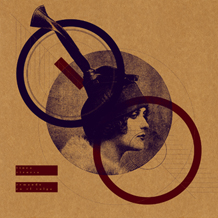LP / Domestica Records / 2012
lim. edition 250 copies with special insert
“Last night, after the unique “bis” by Linea Vienesa –unique mainly due
to the lack of repertoire than of applause-, the handsome Brummell
whispered in Baudelaire’s ear while he was removing his mythical and
delicate gloves: “they are, how can I say?, really peculiar your
friends, “darling””.
That is how Tomás Cuesta ended his review about the first rock concert
by Línea Vienesa, in the newspaper ABC on July the 8th 1981. Two days
before, they had done their presentation in the Golden Village in
Madrid.
Ramón G. del Pomar wanted to set up a rock band. He played the guitar.
He had already got in touch with a bass player, Patricia Álvarez de
Lorenzana, but he needed a singer and a keyboard player. He met Mavi
Margarida in some night party in Madrid, and he was fascinated by her
lips painted in blue, matching her raincoat. “Would you like to sing?”
he asked her. Mavi was studying in the school of the dancer Antonio
Llopis, “Teatro de la Danza”, so she told him “if you want, we can try”.
Hired. Then Mavi brought in Ricardo Llorca, a piano student in the Real
Conservatorio de Música de Madrid.
It was in the winter of 1981 when they entered Mario del Castillo’s
rehearsal premises, with a rented synthesizer, a drum machine Körg, a
guitar Gibson (which had belonged to Pete Townshend), a bass Hoffner and
a pair of microphones. The cinema producer Francisco Hoyos was in
charge of the expenses.
“The music by Línea Vienesa lies in so many poles that the links would
be too long. We just have to focus on the use of the drum machine, its
walks on the Renaissance music which, from time to time, is sung in
German (although it is not very understandable) and which is, in the
end, music made to entertain as well as to listen to it carefully”
José Manuel Costa. Newspaper El País, July 10th 1981.
The group was not created according to a specific concept. Songs began
to arise spontaneously: a guitar riff here, a synthetizer melody there,
now a syncopated rhythm and a powerful bass. Many hours of rehearsal. A
poem by a friend who was musicalizing, a song compounded in the car
during a traffic jam, a modernized “copla” in their parents’ home piano,
and an interest towards the aesthetics that all of them shared. Up to
that moment, any Spanish music group had not used a drum machine to play
pop. And that was the first Spanish group out of the commercial
circuits which all the national written press echoed.
“What is amazing in Línea Vienesa is, in the first place, how clear they
have their purpose. The work done and the drum machine have had good
results, the compositions have a strange consistency and they are able
to lead everything to the best port”
José Manuel Costa. Newspaper El País, July 10th 1981.
“…and we will say, write that, what they do perfectly is a sort of
jet-pop vaguely teutonic, something new and fun: pop as something
grotesque, elite desguised as elite, to sum up, a buzz.”
Agustín Tena. Newspaper Pueblo. July 10th 1981.
Concerning time, they coincided with the neo-romantic movement, which
allowed them to display their energy both on the stage and in the
changing room. Mavi Margarida created the group image, which the other
members received delighted. And with a meticulous look in their first
concert (all black and white), they showed a great staged display where
every member in the group designed his own character matching the
environment they had created.
“Rather than plagiarizing, Línea Vienesa has appropriated some of the
elements from their English members to adapt them here showing
professional good sense. They, as well as Visage or Spandau Ballet (who
are going to perform on the same stage on Sunday,) reject the technique
as the purpose to reduce it to the limits of pureness and simplicity.
They go from the exhibitionist virtuosity to the exhibitionism of ideas.
The important thing is that imagination is developed enough to stage a
show ”
Tomás Cuesta. Newspaper ABC July 9th 1981
“These boys don’t have many neo-romantic traits, which is not a problem.
We must thank their care regarding their manners and dressing, as well
as their lack of musical pretentiousness. No mystics at all,
fortunately, just modern music: a great synthesizer , a careful bass
player with the air of an English soldier exterminating Zulues, an
effective and pale guitar player, a pretty soloist… ”
Diario Pueblo. July 10th 1981
They counted on many friends’ help. The designer Jesús del Pozo, Mavi’s
uncle, lent the wardrobe to the two women in the group and advised the
men for the second concert in Rock Ola. The writer Jorge Berlanga wrote
two poems with the aim to be used as lyrics for his songs (“Cangrejos en
la Cocina” and “Amor de Primavera”). The painer Sigfrido Martín Begué
collaborated in the stage display for Paché discotheque, which would be
his last performance. Sigfrido Martín Begué and Carlos Berlanga were two
true “groupies”, as they liked to call themselves, of Línea Vienesa.
“… Línea Vienesa, the best group emerged this year from the good reserve
in Madrid…” “A dozen of music themes which make the best catalogue
created here up to the date of the new synthesized sensitivity .The best
guarantee that exquisiteness doesn’t have to be something neither twee
nor pedantic for intelligence”
Tomás Cuesta. Newspaper ABC. September 22nd 1981
Four concerts in the capital city, two in July and two in September, a
demo with eight themes recorded in the studio, and the group was
dissolved.
That is how Tomás Cuesta finished the written chronicle on Línea Vienesa’s second concert in Rock Ola:
“After an hour of concert, when the members of Línea Vienesa left the
stage, the night was beautiful, cheerful and easy. The spirits of
talent, excitement and surprise had been conjured up and were wandering
over there, between the plants, being pampered, curled up…”




